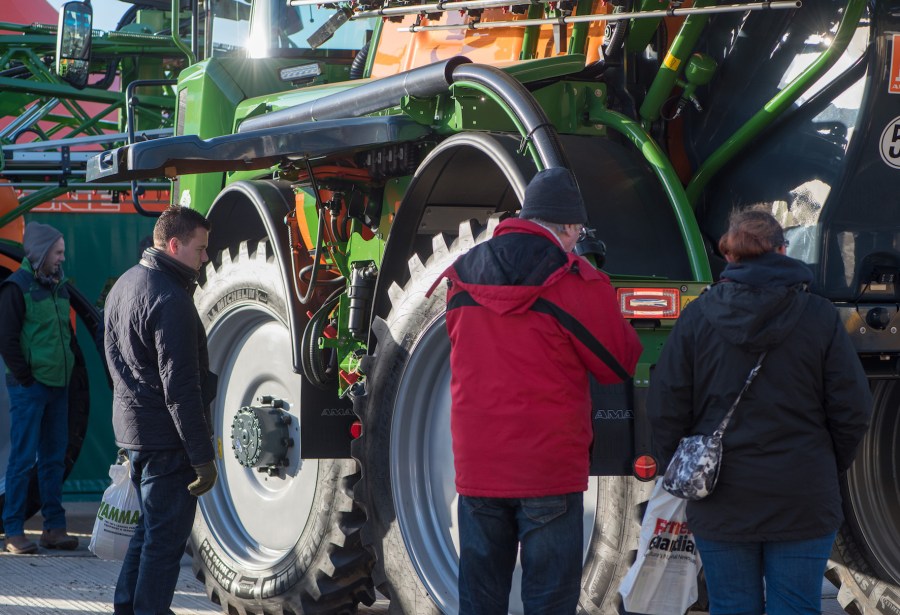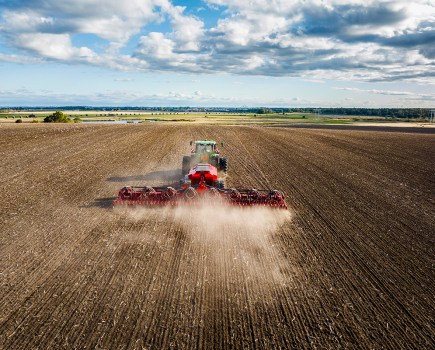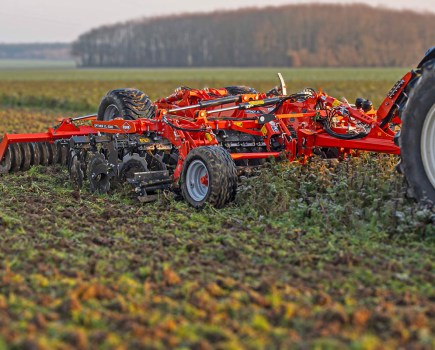Britain’s leading agricultural machinery event has a new venue, tucking gleaming new kit into the warmth of Birmingham’s NEC. CPM previews what will be on display.
All bodes well for a positive event.
By Peter Hill
LAMMA 2019
Where? National Exhibition Centre (NEC), Birmingham B40 1NT
When? Tuesday, 8 January, 8.30am – 5.30pm
Wednesday, 9 January, 8.30am – 4.30pm
It’s all change for the next LAMMA show. No more wind-blown open stands, rain, frost and muddy ground.
And all being well, no more queuing around the block to get into the car park, nor to get out again because in addition to the NEC being very well located, with good road, rail and air connections, it’s remarkably efficient at getting large numbers of car-borne people in and out.
The National Exhibition Centre on the outskirts of Birmingham will host the event for the first time, so all exhibits will be housed indoors, under cover and in relative warmth.
It’s costing stand holders more to exhibit but, for show visitors, organiser AgriBriefing has done its sums to secure free parking and free entry to all show visitors.
Add in a strong exhibitor presence with the promise of masses of information for growers prepared to seek it out, and plenty of shiny new machinery to whet the investment appetite, and all bodes well for a positive event.
Consistent cultivations
Monitoring cultivation depth to achieve consistency across different soil types and conditions is set to go electronic with new systems launched in North America likely to make their way to European implements in time.
AGCO’s Till Control for the Sunflower range of cultivators and AFS Soil Command from Case IH use sensors to display the working depth of each bank of soil-engaging tools on an ISOBUS screen in the tractor cab.
Operators can then adjust the implements on the move to aim for a seedbed of consistent quality across the field.
First out of the starting blocks with similar technology in Europe is Danish manufacturer Dal-Bo; its Depth Control system uses an ultrasonic sensor on the implement connected to an LCD display in the cab.
It portrays the aggressiveness and working depth of the tines, explains the manufacturer, enabling the operator to check settings easily – and certainly more easily than trying to read a distant mechanical scale in dusty or low light conditions.
The display enables an operator to keep an eye on settings after each headland turn without having to twist around each time.
A more durable arable roller ring is promised by Dal-Bo for the new Snowflake design, which has six ‘Y shaped spokes rather than the usual four straight ones to distribute stresses more evenly around the ring casting.
The ring has a broad contact surface with a wavy central rib to break clods while consolidating finer tilth to conserve moisture within a seedbed.
The patented and design-protected ring, which has been under development and testing since 2013, is now available on Dal-Bo CombiFlex, MiniMax, PowerRoll, MaxiRoll and MegaRoll – up to 24.3m – implements in 500mm, 550mm, 600mm and 650mm diameters as appropriate.
Bullock Tillage is introducing a new range of heavy duty hydraulic folding Cambridge rolls, which will expand the Worcs-based companys existing range of cultivation equipment.
Sizes of 4.6m, 5.3m, 6.3m, 7.4m, 9m and 12m come with the option of front-mounted hydraulic levelling boards to crumble and level off uneven surfaces before they’re rolled.
A choice of ring types – Cambridge and Crosskill – and diameters will be available, with each roll section individually floating and pivoting to follow ground contours.
Attachment to the tractor is via the ring hitch on most models, although the two largest are attached to the lower link arms and have twin-axle transport wheels.
Two ‘alternative’ designs of cultivation tines and discs from Väderstad aim to deal with particular soils, conditions and situations more effectively than existing options.
First up, the BreakMix point has a prominent vertical tine face combined with a broad upwardly curving section positioned behind and working to a shallower depth.
This layout is designed to crack compacted soils up to 30cm deep, to encourage movement of water up and down the soil profile while also intensively mixing residues in the topsoil.
It’s intended for both primary and secondary cultivation implements and carries Marathon hard metal reinforcements for the surfaces that bear the brunt of the soil’s abrasive characteristics.
With the CrossCutter disc, Väderstad claims improved mixing of trash and soil at shallow depths on stubbles, cover crops and ploughed land.
The heavily profiled 450mm diameter disc is fitted individually on rubber suspended arms to 3m to 12.25m Carrier cultivators.
Added versatility in the tasks they can perform is claimed for the addition of straw tines as an option on He-Va Tip Rollers from Opico.
The two rows of 16mm straight tines that flex on the upper coil section attached to a toolbar equip a Tip Roller to spread chopped straw and chaff behind the combine and create a consolidated stale seedbed.
Lightly working the soil surface can also be beneficial in disrupting slugs and their eggs, with consolidation by the roller rings creating conditions that encourage weed seeds to germinate.
Hydraulic angle adjustment of the toolbars that carry the tines vary their impact on the soil surface, while the hydraulic weight transfer of the Tip Rollers is said to ensure even downforce across the working width of the implement.
Cover crop mashers
The current trend of growing cover crops to harvest the sun’s energy and help add organic matter to soils has created a demand for implements that encourage their breakdown as following crops develop.
For Cousins of Emneth, a front-mounted crimping roller to roll, break and bruise cover crops is the answer as it creates a one-pass operation when used with a rear-mounted drill.
“When rolled down in the direction of planting, the cover crop forms a dense weed-suppressing mat on the soil surface while allowing successful crop establishment,” explains Laura Cousins.
The Norfolk-based manufacturer opted for helical blades on the Crop Check crimper, since having only a small portion of each blade in contact with the crop at any time means the full weight of the implement is applied intensely for maximum breaking and crimping effect on stems to optimise desiccation.
The chevron pattern neutralises lateral forces that could otherwise pull the tractor off its course and eliminates the ‘bounce’ that Cousins says is associated with straight blades.
“We also decided on ‘blunt’ rather than ‘sharp’ blades to avoid cutting through the cover crop and into the soil,” adds Laura Cousins. “This would dislodge residues and increase weed seed germination.”
The 660mm Crop Check roller weighs in at 190kg/metre – with ballast adding up to 150kg/metre – and is available as a complete front-mounted implement or in custom built sections to fit existing Cambridge roller or soil press frames.
Drill developments
Claydon will introduce a ‘compact’ 6m drill that slots into the range between the 4m and 6m full-size trailed seeder.
It uses the familiar OptiTill direct strip-seeding concept shared with other models in the range – a soil-loosening tine followed by a tine coulter at a slightly shallower depth – the floating frame that carries them without bearing the weight of the seed hopper.
Seed capacity is 3500 litres, which is double that of the 6m mounted drill but less than the capacity of the full-size 6m model.
“That version was designed for larger farms and contractors who can make full use of its 5500-litre hopper capacity to maximise the area covered between fills and daily output,” says Jeff Claydon.
“The new T6c is more than 20% lighter and more compact, and has nimble handling characteristics and manoeuvrability behind a 300hp tractor in a combination capable of drilling typically 45ha a day.”
The hopper can be used for seed only or seed and fertiliser with a 60:40 split to get crops off to a fast start, while the 19 individually adjustable tungsten-carbide leading tines reduce compaction and aerate the soil ahead of the coulter tines that create additional tilth and place seed above the drainage channel.
Claydon says this system will operate successfully working directly into stubble, in min-till situations or on ploughed and/or cultivated land, across a wide range of soils, conditions and crops.
Roots and vegetables
With fresh challenges presented by an uncertain Brexit, working ‘smarter’ could be the key to gaining a competitive advantage, suggests Grimme, which is why the potato, beet and vegetable equipment manufacturer is showcasing advances in its i-Systems technology.
Clever Planting is designed to enable growers to maximise yields without increasing acreage by using GPS location, auto spray tacks shut-off and Section Control to automatically regulate the density and volume of seed passing through the planter elements.
This i-Systems package, which is operated through Grimme’s version of the CCI touch-screen ISOBUS terminal, is available as an all-feature package for the GB 430 planter, with the majority of features also available for the GB 215 and GB 330 models.
The quaintly named ‘Jane’ bed tiller from Maschio via Opico is designed for root crop, vegetable, fruit and flower growers who need to intensively till and form beds in their soils for the next crop.
Maschio’s Jane is based on the company’s range-topping Panterra rotary cultivator and specced for tractors of 200-380hp and arduous conditions.
A double ‘A’ frame headstock, heavily-built chassis and twin folding rams either side are designed to maintain the implement’s integrity and create neat beds using the bed-forming hood.
Low maintenance main rotor end bearings are installed and drive to each rotor is via an oil-immersed gear train.
Drip irrigation specialist Howseman Agriculture will be showing a prototype six-row drip-tape layer to speed up the deployment of a metered water supply in high-value crops.
The company claims to be unique in both supplying and setting up drip irrigation systems, which are said to be capable of making water savings of up to 30% compared with traditional hose reel systems.
Bauer’s new irrigation pump set is a fully sound-proofed package that uses a Caprari MEC pump powered by FPT Industrial or John Deere diesel engines supplied by a 1000- or 1500-litre bunded fuel tank.
The control panel has an integral modem for remote start/stop, throttle control and pump operation via a mobile phone and SmartRain ready for remote monitoring along with Rainstar high capacity reels and other Bauer irrigation equipment.
Crop spraying
Two new spray nozzles are promised by Billericay Farm Services (Bfs), one of which – the ExRay XC – combines air induction for low drift and a flexible pre-orifice to cover a wide range of flow volumes.
This is designed to cater for spraying vehicles likely to work at a wide range of speeds, in fields that are flat in parts but also with steep banks, for example.
Increasing sprayline pressure brings a corresponding increase in flow rate, says Bfs, to compensate for an increase in forward speed but without impacting negatively on the low-drift spray characteristics.
The Bfs PulZar is being introduced here after sales experience in North America where it’s used with pulse width modulation spraying systems.
These enable application rate to be varied on the move without changing system pressure for consistent spray characteristics by pulsing the spray on and off; output is increased by extending the ‘on’ pulse.
The PulZar is a conventional low-drift option for such a system.




